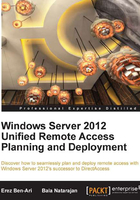
Faster is better
Another improvement that Unified Remote Access offers is in the performance department. Unified Remote Access, when installed as a Hyper-V guest VM in a Hyper-V host running Windows Server 2012, can utilize Single Root I/O Virtualization (SR-IOV), which allows it to perform better when the server is virtualized. SR-IOV is a specification that allows a PCIe device to appear to be multiple separate physical PCIe devices, and when properly implemented within the BIOS and operating system, it can improve data transfer performance significantly.
In addition, Unified Remote Access provides improved performance of both the transition technology protocols Teredo and the IP-HTTPS connection option. IP-HTTPS is one of several possible client connectivity options, and with the IP-HTTPS in DirectAccess with Windows Server 2008 R2 and UAG, data would be encrypted both with IPsec and SSL. This double-encryption was overkill that consumed significant CPU resources, and now in Windows Server 2012, the IP-HTTPS uses SSL without encryption (the technical term is null-encryption), which reduces the CPU usage and thereby improves data transfer rates. In Windows Server 2012, the underlying IP stack has also improved a lot. One of the improvements is providing Receive Side Scaling (RSS) for UDP traffic as well. This allows the Teredo traffic (which is based on UDP traffic on port 3544) to utilize all cores of the CPU, and thereby uniformly spread the load across all of the cores. This allows more client density per server, allowing higher scale deployments.
The built-in PowerShell cmdlets allow the Unified Remote Access role to be installed on a Windows Server in Server Core. Server Core mode is a server that is installed with a reduced set of services and options, allowing tighter security and improved performance, as less resources are used by the operating system, freeing them up for use to service users accessing remotely.
Lastly, Unified Remote Access provides the ability to offload the IPSec encryption to specialized hardware. By using dedicated hardware, the system's CPU is free to handle other tasks, improving the capabilities of the server beyond what additional CPUs and memory can provide.